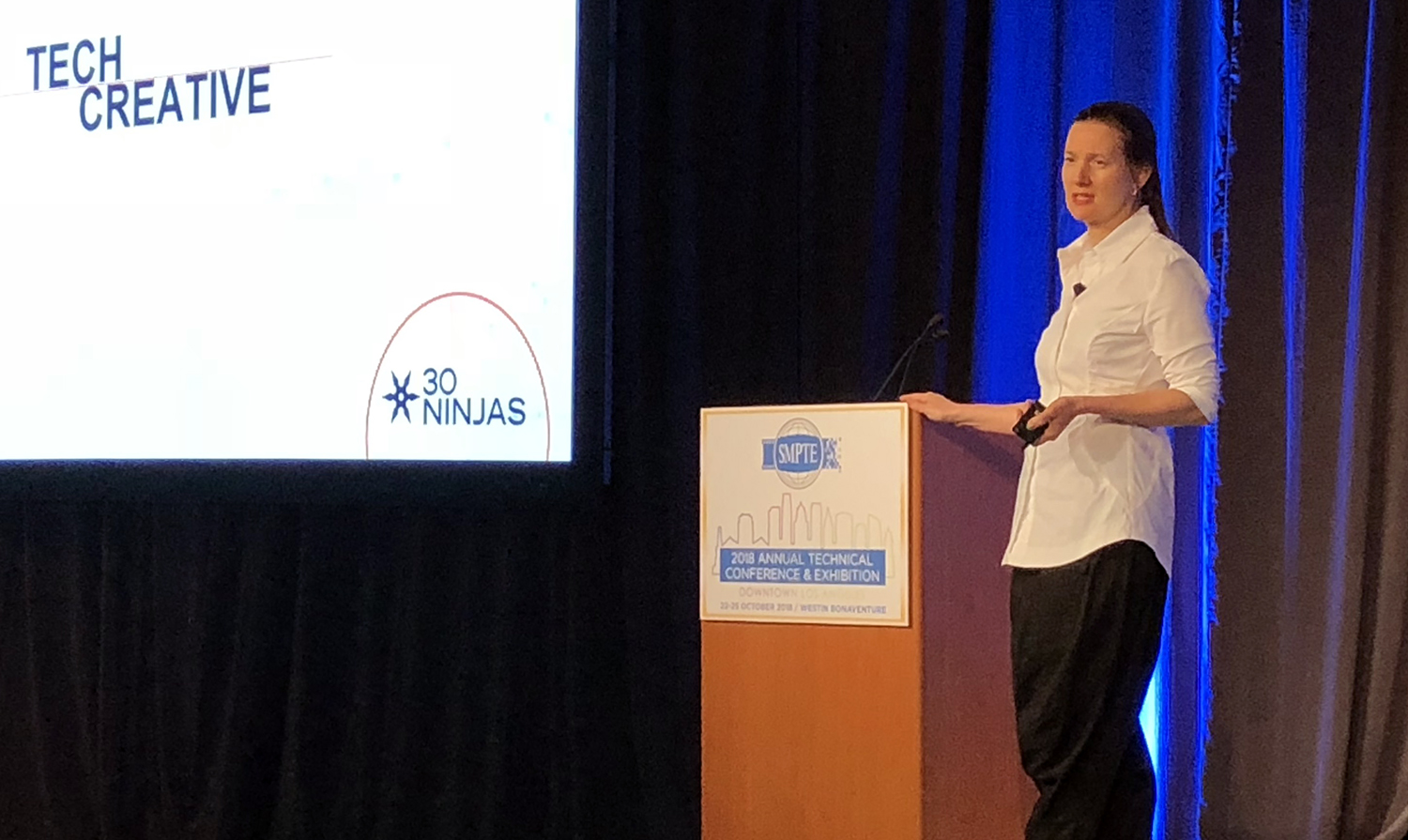With New Venue and Business Plan, SMPTE Looks to the Future at Annual Tech Conference
SMPTE 2018 papers address UHD/HDR, IP media workflows, AI, OTT, the cloud
Story Highlights
With the media and entertainment industry in the midst of rapid technological change, the annual SMPTE Technical Conference and Exhibition made a change of its own: migrating from its long-time Hollywood and Highland locale to the Westin Bonaventure in Downtown Los Angeles. Whether it was a change in venue or a change in technology, the industry’s rapid transformation was apparent throughout the conference, which delved into a cavalcade of emerging technologies: AI and machine learning, UHD and HDR, IP media workflows, the cloud and virtualization, OTT and streaming, VR, and more.

An opening keynote by 30 Ninjas CEO Juliana Tatlock and the 2018 SMPTE Technical Conference focused on how technology and creative teams can work together to create immersive experiences for VR, 360, AR, and mixed reality.
In addition, an opening keynote from 30 Ninjas CEO Juliana Tatlock focused on how technology and creative teams can work together to create immersive experiences for VR, 360, AR, and mixed reality.
Said SMPTE President Matthew Goldman, SVP, technology, MediaKind, during his opening comments, “The SMPTE annual tech conference and exhibition is one example of the way the society offers education so you can stay ahead of emerging technologies and receive practical information that you can use to advance your technical expertise, futureproofing both your career and your organization.”
The Roadmap: New Strategic Business Plan Unveiled
Fresh off electing Patrick Griffis, VP of technology in the Office of the CTO, Dolby Laboratories, as its next president (he takes office Jan. 1), SMPTE announced completion of a new strategic business plan during its Annual General Membership Meeting.
The plan, which was introduced by Griffis and will be overseen by the SMPTE Board of Governors, features a refreshed mission statement focused on facilitating industry interoperability by setting industry standards, providing relevant education, and fostering an engaged membership community. The strategic plan further includes the society’s first formal vision statement: SMPTE enables the technical framework and global professional community that makes motion-picture, television, and professional media available for all humanity to enjoy for artistic, educational, and social purposes.
The Keynote: Tech, Creative Unite for Truly Immersive Experiences
Tatlock, who co-founded 30 Ninjas with Hollywood director Doug Liman, kicked off the festivities on Tuesday as keynote speaker, providing an overview of how 30 Ninjas fuses technology with creativity to develop, write, and produce dynamic 360, VR, AR, and mixed-reality interactive content. She chronicled how 30 Ninjas’ projects have evolved from a spy story told over Twitter feed in 2008 to production of Invisible, the first large-scale 360 VR series, in 2016 to the multitude of current projects.
“The thing about storytelling is that any good story is immersive,” she said. “It’s necessarily the technology that makes it immersive; it’s the combination of both the creative and technical. Our creative works with our tech, and our tech works with our creative. Neither one leads, and yet both lead at the same time. We need to work hand in glove.”
Recent projects by 30 Ninjas include the Jack Ryan Training Field (in partnership with MediaWorks), a hyper-realistic 4D experience at this year’s Comic-Con that allows visitors to navigate a 30-ft.-high obstacle course while wearing an Oculus Rift VR headset featuring content integrated with the physical course.
In addition, 30 Ninjas worked with Verizon on a VR test that leveraged 5G connectivity at Super Bowl LII to deliver a live VR experience to a suite at US Bank Stadium, as well as to a small group of Verizon employees at the Verizon Open Innovation Center in New York City.
“How do we look forward to what’s coming but, at the same time, make entertainment for today?” asked Tatlock during her speech. “What do we learn along the way, and how can we develop a creative process between technology and creative so that we can keep creating excellent experiences?”
The Conference: Better Pixels, IP Revolution, AI, and more
This year’s Technical Conference, led by Program Committee Co-Chairs Thomas Edwards and Sara Kudrle, featured papers addressing the most pressing technological issues facing the media and entertainment industry today and in the future.
Following Monday’s annual SMPTE Symposium, Tuesday’s program was headlined by the Better Pixels track: a full-day program detailing latest developments for UHD, HDR, HFR, and WCG. Papers also addressed artificial intelligence, blockchain, security, file workflows, and displays.
A full-day track that focused on IP and the evolution of the ST 2110 suite of standards, as well as SMPTE standards for media-over-IP workflows, topped the Wednesday program, which also offered papers on cloud-based workflows, encoding, image quality, AI, OTT, and storage.
The 2018 conference closed out on Thursday with a track titled “Innovating People: Management, Culture, and Inclusion,” which focused on the strategies for technology and M&E organizations to improve corporate integrity and the importance of visibility in achieving inclusivity for women. Papers also were presented on VR, IP, OTT, production and postproduction case studies, the future of timecode, image acquisitions, and the future of lighting
The Annual SMPTE Awards Gala on Thursday night capped the event by honoring industry luminaries and exceptional students.
Exhibition Floor: 100 Tech Vendors, UHD Demos, IS-06 Interop
In addition to the technical conference, this year’s exhibition featured technology displays from more than 100 vendors, as well as a pair of demos organized by SMPTE. The first featured several pieces of UHD video content displayed at a variety of frame rates and randomly applied special subsampling, allowing attendees to vote on which content looked the best. The second was a multivendor AMWA NMOS IS-06 interop, which demonstrated network interfaces for the following functions: discovering network topology, authorizing end-point devices, routing flows from senders to receives via optimal paths, bandwidth management, and more.
